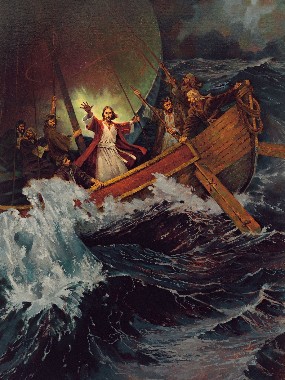
Porter-Pathway
Primary General President Susan H. Porter speaks during a BYU–Pathway Worldwide devotional, broadcast on Tuesday, April 2, 2024. 2024 by Intellectual Reserve, Inc. All rights reserved.This story appears here courtesy of TheChurchNews.com. It is not for use by other media.
By Mary Richards, Church News
Sometimes, people may feel like they are living in a storm. Life can feel in commotion during uncertainty over the future, including challenges with families, finances or health.
While reflecting on these difficulties of life, Primary General President Susan H. Porter has thought about what can be learned from hurricanes.
While hurricanes are massive storms — often hundreds of miles or kilometers wide and with strong winds — in the center is a place of calm called the “eye.”

Porter-Pathway
In a BYU–Pathway Worldwide devotional broadcast on Tuesday, April 2, 2024, Primary General President Susan H. Porter shares a photo of the eye of a hurricane. Photo is a screenshot from byupathway.org, courtesy of Church News.All rights reserved.The strongest and fiercest winds are closest to the eye, forming what is called the “eyewall.” So if a person is standing in the center of the storm and looking around, all he or she would see is chaos.
During her BYU–Pathway Worldwide devotional on Tuesday, April 2, President Porter asked, “When winds are blowing and swirling around us, how can we get to the ‘eye’ of our storm and not be discouraged by the most intense challenges directly in front of us?”
She suggested four steps each person can take: stop, pray, remember and move forward.
1. Stop
President Porter said sometimes “we need to stop, stop worrying, stop running faster than we have strength” and instead get centered and reach heavenward.
“Every time we are feeling overwhelmed, we can pause, take our eyes off the confusion that surrounds us and look up to God,” she said.
President Russell M. Nelson invited all to “think celestial” and look toward an eternal reward rather than focusing on the difficulties of the day.
2. Pray
As people pray in faith, it is as they are looking up toward a loving Heavenly Father, who knows the storms they are facing.
“We can ask Him for peace, strength and clarity of thought to know how to understand and deal with all that is unclear around us,” President Porter said. She shared how President Nelson taught that prayers can and should be living discussions with Heavenly Father.
Places where the winds are calm and peace prevails can be places to stop and pray. These include temples, chapels and homes.
But “the Savior has the power to help us be centered in Him, even when we cannot get to a place of calm,” President Porter taught.
When Jesus’ disciples were in a ship on the Sea of Galilee, a great storm arose and they feared for their lives. They found the Savior asleep. He arose and rebuked the wind and calmed the sea.
Said President Porter: “We can exercise our faith in the living Son of the living God. Through His great and atoning sacrifice, the Savior has power to help us overcome the storms of this life. We can go to the Father in humble prayer, in the name of Christ, and receive peace amid our storms.”
3. Remember

Porter-Pathway
Stilling the Storm," by Ted Henninger. 2024 by Intellectual Reserve, Inc. All rights reserved.During the midst of storms, people can remember times in their lives when they have known that God loves them and is aware of them. They can remember when they have received heaven’s help.
And they can remember their covenants. “No force of wind can break the bonds of the covenants we have made with Heavenly Father and His Son in baptismal fonts and in holy temples. When we strive to honor those covenants by living His commandments, we invite the Savior to uphold us in our storms,” President Porter said.
People can also remember that hurricanes may be massive and strong, but they are temporary. Clear skies return when the storm runs out of force. Those who are anchored to the Savior during the storm will be stronger when the storm passes.
4. Move Forward
Those who stop, pray and remember can “press forward with … a perfect brightness of hope” (2 Nephi 31:20). That hope is centered in Jesus Christ and His capacity to strengthen and direct one’s path.
President Porter shared an experience she had in the hospital when her husband, the late Elder Bruce D. Porter, a General Authority Seventy, had undergone surgery and his health was declining rapidly. They were many miles away from home, and she felt alone and helpless.
“I felt like I was in the middle of a storm over which I had no control,” she said.
She stopped and looked for a peaceful place — a quiet and empty stairwell — where she offered a prayer. The next morning, as she fasted and walked the halls of the hospital, her phone rang with calls from loved ones offering support to her.
“I realized that what the Lord was offering first was not answers or solutions to Bruce’s precarious health situation,” she said, “instead, He was clearing the skies so that I could feel His love and care. I was in the eye of the storm with the Savior at my side.”
She reminded the students that God is aware of them and will help them. “You are His child. He loves you.”
Copyright 2024 Deseret News Publishing Company.